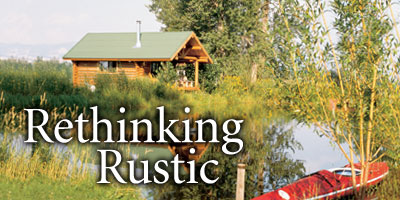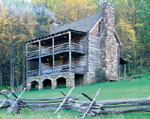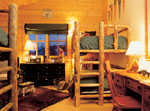
By Peter Lindblad
Remember that smelly old outhouse back in the trees? It's gone, replaced by indoor plumbing. That woodburning stove that barely pumped out enough heat to keep you from freezing now has help in the form of a furnace to keep its owners warm. And instead of using the campfire to cook and reading by candlelight, a lot of cabins have a stove to make gourmet meals and enough electric light to keep you from going blind.
 "The ones we all grew up with, the ones your grandma and grandpa used to own that had indoor plumbing if you were lucky, those are gone for the most part," says Brian Breit, national sales manager for Wilderness Log Homes.
"The ones we all grew up with, the ones your grandma and grandpa used to own that had indoor plumbing if you were lucky, those are gone for the most part," says Brian Breit, national sales manager for Wilderness Log Homes.
"Nobody's roughing it anymore." Joe Folker, director of network services for Kuhns Bros. Log Homes, agrees. "What used to be very rustic, very basic structures have become filled with amenities you'd find in primary residences," he says. "People don't want to sacrifice the conveniences they have at home."
Traditional Values
We all know what a cabin or camp is when we see it. By definition, a cabin is a small, roughly built house and sometimes a camp isn't much more than a shack. Those notions are changing. Many of today's cabins and camps resemble primary homes.
Still, the basic architectural features haven't changed all that much. The designs often aren't very complicated. "Architecturally, they're usually very simple," Breit says. "They have simple roof lines, although some may have shed roofs or gable roofs." That simplicity extends to the interior, which features a lot of wood in the walls.
"Typically, these are two-bedroom places," Breit says. "If you need more places to sleep, the loft layout may be sleeping quarters. Most have open design concepts. There are not a lot of interior walls. All the rooms open up to each other, with the exception of the bathroom. Open design concepts can be popular with main homes, too, but you don't see it all the time like you do with camps and cabins."
Often, camps and cabins are built on piers or slabs, as opposed to having full basements. The heating and cooling systems are often seasonable, so many of these places are not four-season structures. Instead of big fireplaces, camps and cabins usually have woodburning stoves or smaller fireplace collections.
A lot of camps and cabins don't have garages. If they do, it's usually a one-car garage or a storage unit for a boat and other toys. What a lot of camps and cabins have in common is a porch or a deck for spending time outside. More often than not, these structures have a lot of glazing to view the natural wonders of their property, like meadows or lakes or the woods. "There's often a common area with a glass wall of some sort," Breit says.
Changing Times
The old log cabin isn't what it used to be. Today, the designs are bigger than ever, with some homeowners envisioning such structures eventually becoming retirement homes.
"Camps and cabins have really turned the corner," Folker says. "In the past, they were nothing more than large bunkhouses. The camps and cabins of today are more like cottages with all the amenities."
Features like a dishwasher, refrigerator, granite countertops, plush carpeting, a stocked bar for entertaining, expansive glass and outdoor cooking and preparation areas are becoming more common.
"People want a return on their investment," Folker says. "You don't want to take a $300,000 piece of property and set a $50,000 house down on it. Now these places are four-season homes you can visit anytime of the year you want."
Lynn Gastineau, owner of Gastineau Log Homes, has also noticed that camp and cabin designs are more elaborate. "Bigger, bigger, bigger — that's what we're seeing, and more amenities," Gastineau says.
 "It used to be people would come in and want something simple to keep the price down. Now, they're coming in wanting places that cost as much as their regular homes. These places are much more high-end, and we're seeing very expensive designs with huge window walls. People are building in places with great views, so they want lots of glass and lots of decks and porches."
"It used to be people would come in and want something simple to keep the price down. Now, they're coming in wanting places that cost as much as their regular homes. These places are much more high-end, and we're seeing very expensive designs with huge window walls. People are building in places with great views, so they want lots of glass and lots of decks and porches."
Things To Keep In Mind
More often than not, a camp or cabin is built way off the beaten path. The privacy is nice, but being so far removed from civilization brings challenges.
Setbacks and zoning. Many camps and cabins are built on waterfront property. Most of the time, that means tight building sites.
"You've got to keep in mind setbacks, the water and lot lines," Breit says. "A lot of people come in with grandiose ideas and the place they want doesn't fit the property. People are often surprised the setbacks go back as far as they do."
The same thing goes for zoning. You want to be able to use your land the way you want, so check the regulations and zoning laws affecting your property.
Septic and well. It's important to know if you need a septic system, first off, and if you do, you need the proper permits and must find out what type of system will work for your particular piece of property.
Access to utilities. If you're going to be using your camp or cabin a lot, you'll probably want it to have electricity and running water. To find out if you can get service, talk to your Realtor. If they don't know, call the local utilities.
Road access. If you're building, you need a road for shipping materials to your construction site. Maintenance. The last thing camp or cabin owners want is a place that's high maintenance. There are steps you can take to make your camp or cabin easy to take care of.
One Last Word
When buying vacation property or designing and building a retreat, try to be accommodating to everyone in your family. "They aren't just hunting and fishing lodges anymore," Folker says. "They're now weekend retreats for families."











